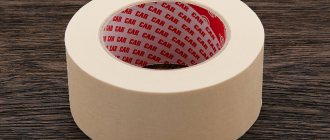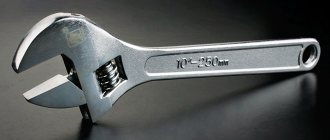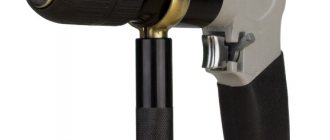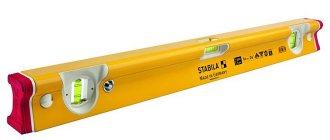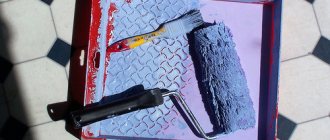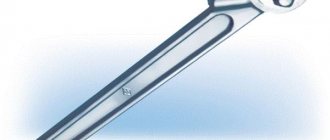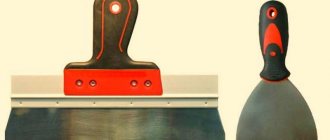Non-standard applications
- Collect broken glass with the adhesive side of the tape.
- Small scattered parts or very tiny ones, such as beads, needles, etc., can easily be collected on the surface of the masking tape.
- Create various markings and inscriptions on the wall, including logos with a clear edge.
- A paper funnel is formed and attached to the wall to collect construction dust when drilling holes in the wall in the absence of a vacuum cleaner.
- If you need to measure a large length with a tape measure, and there is no assistant, then one edge of the tape measure is glued with masking tape and the measurement is taken.
- If you need to drill into a smooth surface on which the drill will slide, apply tape at the entry point of the drill and make a mark for drilling. The tool will not slip and you will make an accurate hole.
- Sealing old wooden windows for the winter.
- Crepe tape is used for sealing seams and joints, limiting the flow of sealant beyond the desired area.
- Pasting door panels during installation to avoid damaging them.
- Taping furniture during transportation with masking tape and bubble wrap in the absence of standard tape.
- Like a phone holder.
Which masking tape is best?
When purchasing, take into account the parameters of strength, thickness, resistance to temperature changes, and UV radiation. A reel with a winding of 50 mm by 50 m is considered standard. Different glues are used in the production of tape:
- rubber
– with low resistance to high temperatures and maximum adhesion; - acrylic
– has good stickiness, performs its functions in a wide range of temperatures, from sub-zero to 120ºС; - silicone
– withstands temperatures up to 250ºС.
The gluing time is also taken into account - if you overexpose the crepe, it will be difficult to remove it. When choosing a product, the intended purpose is taken into account. Wide masking tape with heat-resistant properties is used when painting cars; double-sided tape adheres well to uneven and rough surfaces. If there is no fastener, tape can be used for temporary fixation.
Painting tape color
The color of a product does not always affect its characteristics. Some manufacturers associate the color scheme with the intended purpose. Yellow crepe is considered universal. Blue masking tape is waterproof and heat resistant. The classic white color is useful for sealing cracks on windows, purple - for working with drywall, when gluing wallpaper.
Main characteristics
Painting tape is an adhesive tape that can restrain paint from flowing and reliably protect the surface due to its textured surface.
The adhesion level of painter's tape is lower than that of ordinary tape; it does not leave marks and does not tear off the paint when torn off. The adhesion level is fixed on a scale of 1-100. For wall painting work, index 50 is sufficient.
There are a number of the most important characteristics of masking tape that are worth paying attention to:
- Material.
- Dimensions and weight.
- Marking.
- GOST
Types of masking tape
Krepp differs in purpose, size, thickness. Product classification:
- heat-resistant
– resistant to high temperatures +110…+150ºС; - paper
– to protect cargo from scratches; - radius
– for surfaces with curves; - double-sided masking tape
– represented by two adhesive surfaces; - fabric
- for marking equipment.
Painting crepe has a high degree of adhesiveness and is resistant to sudden temperature fluctuations. Adhesive tape based on aluminum and foil is used to seal pipe joints in the production of refrigeration equipment. Lapel - for masking rubber seals, represented by an adhesive and narrow plastic part. For covering during construction work, use protective film or paper with masking tape.
Masking tape material
The main type of material for masking tape is a paper base of crepe paper, onto which a layer of natural or synthetic rubber adhesive is applied.
This gave certain properties:
- Work at temperatures up to 80 degrees and above, in some species up to 120.
- Frost resistance from -10, but you need to check this on the packaging of each manufacturer.
- Excellent strength, removal from the surface with a “stocking” without torn edges.
- Moisture resistance and resistance to UV radiation (not for all types).
- Compatible with different types of paints and solvents (special tapes for car painting).
Also used as the main material are polyethylene, polypropylene, bitumen, fabric paper, foil, but for painting walls it is the paper crepe base that is used.
What is masking tape?
The crepe is made on a paper (fabric) basis, and the reverse side is treated with natural rubber glue. The protective layer is not damaged by contact with paint, putty and other construction liquids. Masking tape differs in size, winding, and density. Wide tape is useful for protecting window sills from paint, narrow tape is useful for sealing joints between pipes. The strength of fixation depends on the density; for construction work it is better to purchase fasteners with a parameter of 130-140 microns.
What does masking tape look like?
To perform its functions, the tape must have low mass, good absorbent properties, and a rough surface. The appearance of the product depends on the scope of application. Paper-based adhesive tape is a tape made of crepe paper, with glue applied on top. In construction, crepe based on foil, polyethylene foam, and polypropylene is used. The tape is supplied in reels.
GOST and marking
GOST 18251-87. This standard applies to wet-activated adhesive tapes used for gluing veneer, plywood, gluing cardboard boxes, gluing plexiglass and gluing telegrams.
The marking of the crepe tape is indicated in GOST.
The following grades of base paper should be used to make adhesive tape.
| Brand of adhesive tape | Base paper grade according to GOST 10459-87 |
| A | A |
| A | A |
| B | B |
| IN | IN |
| IN | IN |
| IN | IN |
| D | B according to GOST 19625-83 |
It is allowed to use other types of paper as base paper for the production of tape, provided that the quality indicators of the tape meet the requirements of this standard.
The tape must be produced in reels. The bobbin sizes are indicated.
| Tape brand | Bobbin width, mm | Prev. off, % | Reel internal diameter, mm | Prev. off, % | Reel outer diameter, mm | Prev. off, % |
| A, A | 12, 15, 18, 20, 25 | ±8 | 50, 65, 70 | ±5 | 320, 250, 350 | ±4 |
| B | 60, 80 140 | ±2 ±1 | 50, 65 | ±5 | 350 | ±4 |
| B, B | 50, 65, 70, 75, 80, 100 | ±3 | 70, 75 | ±5 | 250, 320 | ±4 |
| IN | 25, 40, 50, 60 70, 75, 100 125, 150, 180, 200 | ±5 ±6 ±5 | 50, 65, 70 | ±5 | 250, 320, 350 320 | ±4 ±4 |
| D | 10 | ±1 | 50 | ±4 | 190 | ±3 |
The packaging of adhesive tape usually indicates: winding length, tape width, materials, scope of application, maximum permissible gluing times and some other characteristics.
Types by color
The following colors are available for different areas of application:
- Yellow, white – regular masking tape for gluing surfaces before painting.
- Blue - waterproof tape with latex coating for facade work during temperature and humidity changes.
- Green – heat-resistant for work at temperatures up to 80 degrees, has a better adhesive composition.
- Pink, purple - for delicate surfaces, such as plaster, wallpaper, freshly painted walls.
Always check the area of application of the masking tape, and do not rely only on its color.
What is masking tape used for?
The main purpose is to protect surfaces from dyes. In addition, the product is used in other areas of activity:
- sealing cracks in windows;
- book repair;
- decoration of premises;
- brown masking tape – for marking and packaging;
- car protection during painting work;
- sealing joints and seams;
- performing markings;
- in everyday life for cleaning things from pet hair, collecting broken glass, in needlework.
Using crepe, you can make a precise border between colors when painting. Masking tape for delicate surfaces is used to join joints when wallpapering. There are non-standard ways to use the product - if you cover a tin can, the paint will not flow into the grooves. The tape easily attaches to furniture and allows you to protect cabinets and mirrors when moving.
Protective film and paper with masking tape
Small reels, the top edge of which contains a tape with an adhesive layer, the bottom is rolled out, has a paper or polyethylene base. It is most often used for painting the ceiling to protect the walls from paint if the walls are already painted or have wallpaper on them.
Sold in any construction hypermarkets; several manufacturing companies are represented in the line.
5 reasons not to use cheap masking tape
- It comes off during peeling.
- It is thoroughly saturated with paint during its application.
- Doesn't stick tightly, causing paint to penetrate under the tape.
- It peels off poorly and leaves behind traces of glue that are difficult to remove.
- It peels off along with the paint even after short contact with the surface.
You need to understand that masking tape is not intended to be applied for too long a period of time. It must be removed in a timely manner, in accordance with the manufacturer’s recommendations. Otherwise, particles of dried paint or entire layers may come off along with the tape. As a result, the painting line will be unclear and the intervention of a specialist will be required to correct the defect, or the wall will have to be completely repainted.
How to choose masking tape?
See what the manufacturer indicates and how long you can stick a particular type of masking tape.
You can’t put tape on freshly painted walls right away; you need to wait a while, ideally a day. But if this time is not available, then at least 2-3 hours and use only special tape for delicate surfaces.
Quality checking. Method No. 1
Professionals strongly recommend refraining from buying cheap masking tape. If you have no experience, it’s worth doing a simple experiment. Stick the tape to some surface. Then paint it and peel off the tape once dry. This way you will see if the tape leaves any traces behind and if it takes away some of the paint.
Method No. 2
Pull the edge of the tape a few centimeters and firmly press it back onto the spool, and then pull this edge again. If it also moves away from the spool with force, then you have masking tape with good adhesive properties.
See the scope of application on masking tape; tapes for car painting are considered to be of very high quality, since very high requirements are applied there.
Choose certain types of masking tape with a density of 125 microns or higher. Be sure to look at the price of products from different manufacturers. Often, the more expensive the tape, the better quality it is.
Masking tape manufacturers and prices
1.
TESA
Used for painting walls inside and outside buildings. Allows you to get clear boundaries. This tape is used with all types of paints and varnishes. TESA tape can be easily removed even 8 weeks after paint application. Professionals note only one drawback: after using TESA masking tape, there is no desire to use other tapes. Cost: from 250 rub. Manufacturer: Germany.
2. 3M
Peels off easily and leaves no marks after removal. Adheres tightly to surfaces of any shape. Has a thin elastic base. Can be used at temperatures up to 80 degrees. Considered a professional consumable.
Cost: from 500 rub. Manufacturer: USA.
3.
FOLSEN
Has excellent quality. Recommended for painting work where smooth edges are required. Within 5 days it leaves no traces when removed. Rubber glue is used as an adhesive base.
Cost: on average from 240 rubles. Homeland of the brand: Latvia. Production: South Korea.
4.
SPINO
SPINO masking tape can be applied to plastic, wood and plaster. The adhesive base is made of synthetic rubber and leaves no marks. You can work with the tape at temperatures from -10 degrees.
Cost: from 100 rub. Homeland of the brand: Latvia. Made in Italy.
5.
Beorol
does not come off in pieces when peeled off. It does not leave sticky marks on the surface. Beorol masking tape can be applied to putty walls, wood, metal, brick and plastic.
Cost: from 120 rub. Manufacturer: Serbia.
You should also pay attention to Unibob and Dexter masking tape. Using them, you can achieve high quality painting.
Description of the product and its advantages
Painting tape, the dimensions of which are not an indicator of its quality, can be used both in everyday life and on large construction sites. The width of the tape ranges from 10 to 50 mm, the length of the strip in a roll is 50 m. The most popular thickness of masking tape is 125 microns.
The paper has a slightly corrugated appearance, thanks to which the tape instantly absorbs paint drips. The adhesive layer can be natural (rubber) and synthetic (acrylic). The following properties of masking tape are appreciated:
- light weight;
- good absorbency;
- tight adhesion to the surface;
- no adhesive traces after use; environmentally friendly;
- ease of use;
- no need to use special tools;
- large temperature range of application;
- can be used both outside and inside the building;
- affordable price;
- environmental friendliness.
READ ALSO: What are fire bowls?

